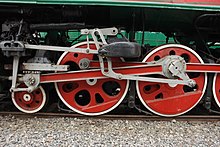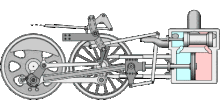Hanging iron


The hanging iron is part of the external backdrop control of a steam locomotive, the most famous of which is the Heusinger control .
Application and purpose
A hanging iron transfers the movement from the throwing lever and thus from the locomotive control to the slide push rod of the Heusinger control. You can see in the photo that by moving the lifting lever, the slide push rod, which is guided inside the double swing arm, is raised or lowered and thus the filling or the direction of travel of the locomotive is controlled. It can be seen that the suspension irons are only moved when the control is operated and are therefore referred to as a maintenance-free connection to the control of the steam locomotive. For easy regulation of the steering wheel, however, an easy gear must be ensured.
On the sketch you can see the classic design of the control of the slide pushrod with hanging iron. But there were other methods of transmitting the movement of the slide pushrods. The variant with the Kuhn loop is well known . The classic control of the pusher rod with hanging iron was preferred for locomotives with tenders with priority for forward travel. For locomotives with frequent fast reverse travel, the Kuhn loop was used instead of the hanging iron in order to achieve even stone jumping when traveling forwards or backwards.
literature
- Edmund Heusinger von Waldegg: Special Railway Technology, Third Volume, Der Lokomotivbau , Leipzig 1882